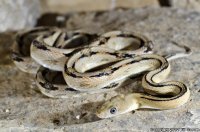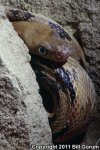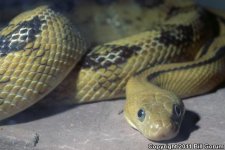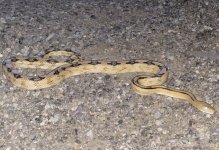| Range: |
 in the south-central and southeastern portions of the state in suitable habitat from about 3,000 to 5,000 feet in elevation in the south-central and southeastern portions of the state in suitable habitat from about 3,000 to 5,000 feet in elevation |
| Other Names: |
Trans-Pecos Snake, Suboc, Davis Mountain Ratsnake, Davis Mountain Pilot Snake, Bogie, H Snake |
| Subspecies: |
Northern Trans-Pecos Ratsnake Bogertophis subocularis subocularis |
| Description: |
B. subocularis has a row of small scales (suboculars) between the lower border of the eye and the upper labials. This beautiful snake is yellow to tan dorsally with a series of black, or dark brown, H-shaped markings. The eyes are large and prominent, light-colored with contrasting round black pupils. The tongue is pink. Dorsal scales in 31-35 rows. Ventrals 260-277; subcaudals 69-79.
Adults are usually 36-54 inches (90-137 cm) in total length (including tail). The record total length is 66 inches (168 cm) |
| Similar Species: |
The H markings on this snake distinguish it from any other snake within its range. |
| Venom: |
None |
| Habitat: |
Rocky terrain with deep cracks |
| Behavior: |
Strongly nocturnal, rarely found during the day. Usually calm, not likely to bite. |
| Hibernation: |
Deep in cracks |
| Reproduction: |
The breeding season for B. subocularis runs through May and June, while egg-laying begins in July and ends by September. At nearly three months, their incubation period is lengthy for a snake, at the end of which a clutch of anywhere from three to 11 snakes, each 28-33 cm (11-13 in) in total length, hatch. As they are born during winter, the hatchlings may remain hidden underground for several months before venturing outside. |
| Diet: |
Mostly rodents, but will take lizards and birds. One was observed in West Texas eating bats through a hole in the road which was on a bridge. |













